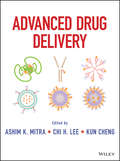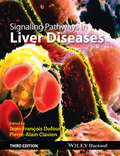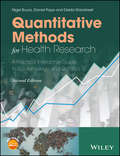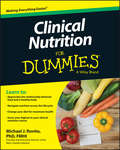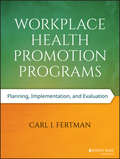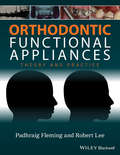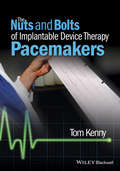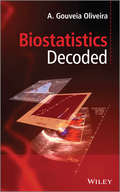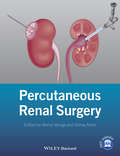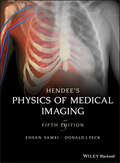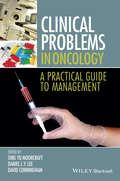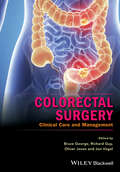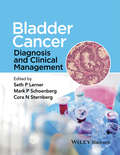- Table View
- List View
Advanced Drug Delivery
by Ashim Mitra Chi H. Lee Kun ChengProvides both fundamentals and new and emerging applications Advanced Drug Delivery brings readers fully up to date with the state of the science, presenting the basics, formulation strategies, and therapeutic applications of advanced drug delivery. The book demonstrates how core concepts of pharmaceutical sciences, chemistry, and molecular biology can be combined and applied in order to spark novel ideas to design and develop advanced drug delivery systems for the treatment of a broad range of human diseases. Advanced Drug Delivery features contributions from an international team of pharmaceutical scientists. Chapters reflect a thorough review and analysis of the literature as well as the authors' firsthand experience developing drug delivery systems. The book is divided into four parts: Part I, Introduction and Basics of Advanced Drug Delivery, explores physiological barriers, stability, transporters, and biomaterials in drug delivery Part II, Strategies for Advanced Drug Delivery, offers tested and proven strategies for advanced delivery of both small molecules and macromolecules Part III, Translational Research of Advanced Drug Delivery, focuses on regulatory considerations and translational applications of advanced drug delivery systems for the treatment of cardiovascular diseases, cancer, sexually transmitted diseases, ophthalmic diseases, and brain diseases Part IV, Future Applications of Advanced Drug Delivery in Emerging Research Areas, examines stem cell research, cell-based therapeutics, tissue engineering, and molecular imaging Each chapter provides objectives and assessment questions to help readers grasp key concepts and assess their knowledge as they progress through the book. Advanced Drug Delivery is recommended for graduates and upper-level undergraduates in the pharmaceutical sciences who need a solid foundation in the basics. It is also recommended for pharmaceutical professionals who want to take advantage of new and emerging applications in advanced drug delivery systems.
Signaling Pathways in Liver Diseases
by Jean-François Dufour Pierre-Alain ClavienSignaling Pathways in Liver Diseases, Third Edition again provides hepatologists and hepatology researchers with an expert overview of the complex and novel cellular/extracellular signaling pathways in the liver, and their role in liver diseases. The last few years have seen a great number of developments in this field, which in turn have led to new opportunities for innovative treatments; however, the intricacy of these pathways and their interactions continue to provide a real challenge for clinicians. This outstanding book compiles the emerging knowledge into a single expert resource, cataloguing and organizing it into an accessible and understandable format. With increased focus on the comprehension of cellular mechanisms involved in steatohepatitis, cirrhosis, and liver tumors, which has led to changes in the management of these diseases, this new edition also sees the introduction of exciting new chapters on key emerging areas such as: Autophagy Notch Pathway P13K/PTEN Signaling in Liver Diseases Sirtuins Hepcidin and Iron Epigenetic Regulation of Hepatic Stellate Cells and Liver Fibrosis Oxidative Stress and Signaling in the Liver. Professors Dufour and Clavien have assembled an all-star cast of chapter authors, each of whom has provided clear and appropriate illustrations to reinforce the text, with a key points box offering a concise and handy summary. Self-assessment questions and answers allow the reader to test their own knowledge. Signaling Pathways in Liver Disease, Third Edition is the perfect educational and reference tool to bridge the information exchange between the laboratory, the clinical ward, and the operating room, and an essential tool for the modern-day hepatologist.
Signaling Pathways in Liver Diseases
by Jean-Francois Dufour Pierre-Alain ClavienSignaling Pathways in Liver Diseases, Third Edition again provides hepatologists and hepatology researchers with an expert overview of the complex and novel cellular/extracellular signaling pathways in the liver, and their role in liver diseases. The last few years have seen a great number of developments in this field, which in turn have led to new opportunities for innovative treatments; however, the intricacy of these pathways and their interactions continue to provide a real challenge for clinicians. This outstanding book compiles the emerging knowledge into a single expert resource, cataloguing and organizing it into an accessible and understandable format. With increased focus on the comprehension of cellular mechanisms involved in steatohepatitis, cirrhosis, and liver tumors, which has led to changes in the management of these diseases, this new edition also sees the introduction of exciting new chapters on key emerging areas such as: Autophagy Notch Pathway P13K/PTEN Signaling in Liver Diseases Sirtuins Hepcidin and Iron Epigenetic Regulation of Hepatic Stellate Cells and Liver Fibrosis Oxidative Stress and Signaling in the Liver. Professors Dufour and Clavien have assembled an all-star cast of chapter authors, each of whom has provided clear and appropriate illustrations to reinforce the text, with a key points box offering a concise and handy summary. Self-assessment questions and answers allow the reader to test their own knowledge. Signaling Pathways in Liver Disease, Third Edition is the perfect educational and reference tool to bridge the information exchange between the laboratory, the clinical ward, and the operating room, and an essential tool for the modern-day hepatologist.
Quantitative Methods for Health Research: A Practical Interactive Guide to Epidemiology and Statistics
by Bruce Daniel Pope Debbi StanistreetA practical introduction to epidemiology, biostatistics, and research methodology for the whole health care community This comprehensive text, which has been extensively revised with new material and additional topics, utilizes a practical slant to introduce health professionals and students to epidemiology, biostatistics, and research methodology. It draws examples from a wide range of topics, covering all of the main contemporary health research methods, including survival analysis, Cox regression, and systematic reviews and meta-analysis—the explanation of which go beyond introductory concepts. This second edition of Quantitative Methods for Health Research: A Practical Interactive Guide to Epidemiology and Statistics also helps develop critical skills that will prepare students to move on to more advanced and specialized methods. A clear distinction is made between knowledge and concepts that all students should ensure they understand, and those that can be pursued further by those who wish to do so. Self-assessment exercises throughout the text help students explore and reflect on their understanding. A program of practical exercises in SPSS (using a prepared data set) helps to consolidate the theory and develop skills and confidence in data handling, analysis, and interpretation. Highlights of the book include: Combining epidemiology and bio-statistics to demonstrate the relevance and strength of statistical methods Emphasis on the interpretation of statistics using examples from a variety of public health and health care situations to stress relevance and application Use of concepts related to examples of published research to show the application of methods and balance between ideals and the realities of research in practice Integration of practical data analysis exercises to develop skills and confidence Supplementation by a student companion website which provides guidance on data handling in SPSS and study data sets as referred to in the text Quantitative Methods for Health Research, Second Edition is a practical learning resource for students, practitioners and researchers in public health, health care and related disciplines, providing both a course book and a useful introductory reference.
Quantitative Methods for Health Research: A Practical Interactive Guide to Epidemiology and Statistics
by Bruce Daniel Pope Debbi StanistreetA practical introduction to epidemiology, biostatistics, and research methodology for the whole health care community This comprehensive text, which has been extensively revised with new material and additional topics, utilizes a practical slant to introduce health professionals and students to epidemiology, biostatistics, and research methodology. It draws examples from a wide range of topics, covering all of the main contemporary health research methods, including survival analysis, Cox regression, and systematic reviews and meta-analysis—the explanation of which go beyond introductory concepts. This second edition of Quantitative Methods for Health Research: A Practical Interactive Guide to Epidemiology and Statistics also helps develop critical skills that will prepare students to move on to more advanced and specialized methods. A clear distinction is made between knowledge and concepts that all students should ensure they understand, and those that can be pursued further by those who wish to do so. Self-assessment exercises throughout the text help students explore and reflect on their understanding. A program of practical exercises in SPSS (using a prepared data set) helps to consolidate the theory and develop skills and confidence in data handling, analysis, and interpretation. Highlights of the book include: Combining epidemiology and bio-statistics to demonstrate the relevance and strength of statistical methods Emphasis on the interpretation of statistics using examples from a variety of public health and health care situations to stress relevance and application Use of concepts related to examples of published research to show the application of methods and balance between ideals and the realities of research in practice Integration of practical data analysis exercises to develop skills and confidence Supplementation by a student companion website which provides guidance on data handling in SPSS and study data sets as referred to in the text Quantitative Methods for Health Research, Second Edition is a practical learning resource for students, practitioners and researchers in public health, health care and related disciplines, providing both a course book and a useful introductory reference.
Clinical Nutrition For Dummies
by Michael J. RovitoGet up to date on clinical nutrition for school, work, or your own health From the proper function of the major organs and the role that proper nutrition plays in their functioning, to a breakdown of carbs, proteins, fats, vitamins, and minerals, Clinical Nutrition For Dummies provides you with the easy-to-read guide you need to immerse yourself in the subject! Written in the fun style that the For Dummies series has become known for, the book is perfect for students in the wide variety of fields that require an in-depth understanding of clinical nutrition, or for those who want to improve their own lives through better nutrition. Dive right into the book for an exploration of the chemical and functional components of food, how to properly assess your nutritional intake, the changing face of nutrition throughout the human lifespan, and so much more! This handy resource offers a wealth of information, and specifically addresses the growing obesity and diabetes epidemics that promise to make the study of clinical nutrition more important than ever. Includes a complete breakdown of the relationship between nutrition and chronic diseases. Explores the nutritional requirements at various life stages, from pediatric through geriatric Features information on the importance of proper nutrition during pregnancy Shares tips for modifying dietary intake and health behavior theory, along with properly communicating health information Clinical Nutrition For Dummies is your complete, fun guide to the topic of nutrition—dive in today to get started on the pathway to mastering this increasingly important subject.
Clinical Nutrition For Dummies
by Michael J. RovitoGet up to date on clinical nutrition for school, work, or your own health From the proper function of the major organs and the role that proper nutrition plays in their functioning, to a breakdown of carbs, proteins, fats, vitamins, and minerals, Clinical Nutrition For Dummies provides you with the easy-to-read guide you need to immerse yourself in the subject! Written in the fun style that the For Dummies series has become known for, the book is perfect for students in the wide variety of fields that require an in-depth understanding of clinical nutrition, or for those who want to improve their own lives through better nutrition. Dive right into the book for an exploration of the chemical and functional components of food, how to properly assess your nutritional intake, the changing face of nutrition throughout the human lifespan, and so much more! This handy resource offers a wealth of information, and specifically addresses the growing obesity and diabetes epidemics that promise to make the study of clinical nutrition more important than ever. Includes a complete breakdown of the relationship between nutrition and chronic diseases. Explores the nutritional requirements at various life stages, from pediatric through geriatric Features information on the importance of proper nutrition during pregnancy Shares tips for modifying dietary intake and health behavior theory, along with properly communicating health information Clinical Nutrition For Dummies is your complete, fun guide to the topic of nutrition—dive in today to get started on the pathway to mastering this increasingly important subject.
Workplace Health Promotion Programs: Planning, Implementation, and Evaluation
by Carl I. FertmanShine a spotlight on the benefits of promoting health in the workplace Workplace Health Promotion Programs focuses on the incredible value that employee health programs can offer by exploring six key topics: behavioral health, physical health, healthy environments, health education, nutritional health, and physical activity. This in-depth resource explicitly establishes what successful workplace health promotion programs, services, and collaborations are, and then builds upon this foundational understanding by introducing methods and tools for promoting employee health and safety, while emphasizing the skills students need to do so. Through this resource, students will come to understand how to recognize employee health and safety opportunities, and how to think on a larger scale when it comes to workplace health initiatives in small, midsized, and larger employers that are comprehensive and fiscally sound. Workplace health promotion programs have the potential to both improve the health of the population as a whole and control healthcare spending in the process. Health problems are estimated to cost employers in the United States over $200 billion per year through medical costs, absenteeism, disability, and overall reduced productivity. Improving well-being through effective workplace health promotion programs can reduce this cost—and create healthier, happier workforces. Discover the design, implementation, and evaluation of workplace health promotion programs that address the range of employee health needs and concerns Understand how evidence-based programs can positively impact business and reduce health care cost Explore the larger scale implications of successful workplace health programs, including health policies, health insurance design, worker safety, employee behavior, etc. Learn how together employers and employees work to create a culture of health and well-being to support and promote employee health and safety Review the ways in which successful workplace health promotion programs can prove financially beneficial Workplace Health Promotion Programs is a resource that guides students and professionals alike in the discovery, development, and execution of successful employee health initiatives.
Workplace Health Promotion Programs: Planning, Implementation, and Evaluation
by Carl I. FertmanShine a spotlight on the benefits of promoting health in the workplace Workplace Health Promotion Programs focuses on the incredible value that employee health programs can offer by exploring six key topics: behavioral health, physical health, healthy environments, health education, nutritional health, and physical activity. This in-depth resource explicitly establishes what successful workplace health promotion programs, services, and collaborations are, and then builds upon this foundational understanding by introducing methods and tools for promoting employee health and safety, while emphasizing the skills students need to do so. Through this resource, students will come to understand how to recognize employee health and safety opportunities, and how to think on a larger scale when it comes to workplace health initiatives in small, midsized, and larger employers that are comprehensive and fiscally sound. Workplace health promotion programs have the potential to both improve the health of the population as a whole and control healthcare spending in the process. Health problems are estimated to cost employers in the United States over $200 billion per year through medical costs, absenteeism, disability, and overall reduced productivity. Improving well-being through effective workplace health promotion programs can reduce this cost—and create healthier, happier workforces. Discover the design, implementation, and evaluation of workplace health promotion programs that address the range of employee health needs and concerns Understand how evidence-based programs can positively impact business and reduce health care cost Explore the larger scale implications of successful workplace health programs, including health policies, health insurance design, worker safety, employee behavior, etc. Learn how together employers and employees work to create a culture of health and well-being to support and promote employee health and safety Review the ways in which successful workplace health promotion programs can prove financially beneficial Workplace Health Promotion Programs is a resource that guides students and professionals alike in the discovery, development, and execution of successful employee health initiatives.
Orthodontic Functional Appliances: Theory and Practice
by Padhraig S. Fleming Robert C. T. LeeComprehensive specialist manual covering the science and practice of functional appliance therapy Integrates clinical and academic elements with emphasis on evidence-based research and its clinical application Suitable for trainee and practicing orthodontists Includes more than 600 photographs to enhance clarity of topics covered Features contributions from top clinicians and researchers in the field
Orthodontic Functional Appliances: Theory and Practice
by Padhraig Fleming Robert LeeComprehensive specialist manual covering the science and practice of functional appliance therapy Integrates clinical and academic elements with emphasis on evidence-based research and its clinical application Suitable for trainee and practicing orthodontists Includes more than 600 photographs to enhance clarity of topics covered Features contributions from top clinicians and researchers in the field
The Nuts and Bolts of Implantable Device Therapy: Pacemakers (The Nuts and Bolts Series)
by Tom KennyTom Kenny, one of the best-known and well-respected educators in EP brings his signature style to this new primer Practical, accessible, highly illustrated approach makes learning easy Provides an overview of the algorithms and devices offered by the world’s five pacemaker manufacturers Offers clinicians learning objectives, test questions and essential points in bulleted lists Perfect introductory guide to the topic, assumes little baseline knowledge and appropriate for residents, fellows, EP nurses, general clinical cardiologists, EP fellows and industry professionals
The Nuts and Bolts of Implantable Device Therapy: Pacemakers (The Nuts and Bolts Series)
by Tom KennyTom Kenny, one of the best-known and well-respected educators in EP brings his signature style to this new primer Practical, accessible, highly illustrated approach makes learning easy Provides an overview of the algorithms and devices offered by the world’s five pacemaker manufacturers Offers clinicians learning objectives, test questions and essential points in bulleted lists Perfect introductory guide to the topic, assumes little baseline knowledge and appropriate for residents, fellows, EP nurses, general clinical cardiologists, EP fellows and industry professionals
Biostatistics Decoded
by A. Gouveia OliveiraStudy design and statistical methodology are two important concerns for the clinical researcher. This book sets out to address both issues in a clear and concise manner. The presentation of statistical theory starts from basic concepts, such as the properties of means and variances, the properties of the Normal distribution and the Central Limit Theorem and leads to more advanced topics such as maximum likelihood estimation, inverse variance and stepwise regression as well as, time-to-event, and event-count methods. Furthermore, this book explores sampling methods, study design and statistical methods and is organized according to the areas of application of each of the statistical methods and the corresponding study designs. Illustrations, working examples, computer simulations and geometrical approaches, rather than mathematical expressions and formulae, are used throughout the book to explain every statistical method. Biostatisticians and researchers in the medical and pharmaceutical industry who need guidance on the design and analyis of medical research will find this book useful as well as graduate students of statistics and mathematics with an interest in biostatistics. Biostatistics Decoded: Provides clear explanations of key statistical concepts with a firm emphasis on practical aspects of design and analysis of medical research. Features worked examples to illustrate each statistical method using computer simulations and geometrical approaches, rather than mathematical expressions and formulae. Explores the main types of clinical research studies, such as, descriptive, analytical and experimental studies. Addresses advanced modeling techniques such as interaction analysis and encoding by reference and polynomial regression.
Biostatistics Decoded
by A. Gouveia OliveiraStudy design and statistical methodology are two important concerns for the clinical researcher. This book sets out to address both issues in a clear and concise manner. The presentation of statistical theory starts from basic concepts, such as the properties of means and variances, the properties of the Normal distribution and the Central Limit Theorem and leads to more advanced topics such as maximum likelihood estimation, inverse variance and stepwise regression as well as, time-to-event, and event-count methods. Furthermore, this book explores sampling methods, study design and statistical methods and is organized according to the areas of application of each of the statistical methods and the corresponding study designs. Illustrations, working examples, computer simulations and geometrical approaches, rather than mathematical expressions and formulae, are used throughout the book to explain every statistical method. Biostatisticians and researchers in the medical and pharmaceutical industry who need guidance on the design and analyis of medical research will find this book useful as well as graduate students of statistics and mathematics with an interest in biostatistics. Biostatistics Decoded: Provides clear explanations of key statistical concepts with a firm emphasis on practical aspects of design and analysis of medical research. Features worked examples to illustrate each statistical method using computer simulations and geometrical approaches, rather than mathematical expressions and formulae. Explores the main types of clinical research studies, such as, descriptive, analytical and experimental studies. Addresses advanced modeling techniques such as interaction analysis and encoding by reference and polynomial regression.
Percutaneous Renal Surgery
by Manoj Monga Abhay RanePercutaneous renal procedures are highly complex and require a great deal of surgical skill. Improve your patient care with this outstanding instruction manual from the experts. Clinically-focused throughout, the three major conditions managed by percutaneous renal surgery – large renal calculi, transitional cell cancer and renal cell cancer – are expertly covered by the world’s leading surgeons and urologists. Well-illustrated with over 100 top-quality surgical photos and with reference to the leading society guidelines in this area, inside you’ll find coverage of: • Evidence-based outcomes for percutaneous management • Patient selection and informed consent • Preparing the patient for surgery • Instrumentation used in surgery • Surgical technique and patient safety • Pre-and post-op counseling In addition, 10 high-quality videos offer an excellent visual guide to best practice and surgical tips and tricks of the trade. Percutaneous Renal Surgery is the perfect multi-media teaching tool, providing urologists, nephrologists and surgeons with the knowledge, confidence and clinical skills required to perform these complex and difficult surgical procedures safely and effectively. Of related interest Smith’s Textbook of Endourology, 3rd edition, Smith, ISBN 9781444335545 Top Tips in Urology, 2nd edition, McLoughlin, ISBN 9780470672938
Percutaneous Renal Surgery
by Manoj Monga Abhay RanePercutaneous renal procedures are highly complex and require a great deal of surgical skill. Improve your patient care with this outstanding instruction manual from the experts. Clinically-focused throughout, the three major conditions managed by percutaneous renal surgery – large renal calculi, transitional cell cancer and renal cell cancer – are expertly covered by the world’s leading surgeons and urologists. Well-illustrated with over 100 top-quality surgical photos and with reference to the leading society guidelines in this area, inside you’ll find coverage of: • Evidence-based outcomes for percutaneous management • Patient selection and informed consent • Preparing the patient for surgery • Instrumentation used in surgery • Surgical technique and patient safety • Pre-and post-op counseling In addition, 10 high-quality videos offer an excellent visual guide to best practice and surgical tips and tricks of the trade. Percutaneous Renal Surgery is the perfect multi-media teaching tool, providing urologists, nephrologists and surgeons with the knowledge, confidence and clinical skills required to perform these complex and difficult surgical procedures safely and effectively. Of related interest Smith’s Textbook of Endourology, 3rd edition, Smith, ISBN 9781444335545 Top Tips in Urology, 2nd edition, McLoughlin, ISBN 9780470672938
Hendee's Physics of Medical Imaging
by Ehsan Samei Donald J. PeckAn up-to-date edition of the authoritative text on the physics of medical imaging, written in an accessible format The extensively revised fifth edition of Hendee's Medical Imaging Physics, offers a guide to the principles, technologies, and procedures of medical imaging. Comprehensive in scope, the text contains coverage of all aspects of image formation in modern medical imaging modalities including radiography, fluoroscopy, computed tomography, nuclear imaging, magnetic resonance imaging, and ultrasound. Since the publication of the fourth edition, there have been major advances in the techniques and instrumentation used in the ever-changing field of medical imaging. The fifth edition offers a comprehensive reflection of these advances including digital projection imaging techniques, nuclear imaging technologies, new CT and MR imaging methods, and ultrasound applications. The new edition also takes a radical strategy in organization of the content, offering the fundamentals common to most imaging methods in Part I of the book, and application of those fundamentals in specific imaging modalities in Part II. These fundamentals also include notable updates and new content including radiobiology, anatomy and physiology relevant to medical imaging, imaging science, image processing, image display, and information technologies. The book makes an attempt to make complex content in accessible format with limited mathematical formulation. The book is aimed to be accessible by most professionals with lay readers interested in the subject. The book is also designed to be of utility for imaging physicians and residents, medical physics students, and medical physicists and radiologic technologists perpetrating for certification examinations. The revised fifth edition of Hendee's Medical Imaging Physics continues to offer the essential information and insights needed to understand the principles, the technologies, and procedures used in medical imaging.
Hendee's Physics of Medical Imaging
by Ehsan Samei Donald J. PeckAn up-to-date edition of the authoritative text on the physics of medical imaging, written in an accessible format The extensively revised fifth edition of Hendee's Medical Imaging Physics, offers a guide to the principles, technologies, and procedures of medical imaging. Comprehensive in scope, the text contains coverage of all aspects of image formation in modern medical imaging modalities including radiography, fluoroscopy, computed tomography, nuclear imaging, magnetic resonance imaging, and ultrasound. Since the publication of the fourth edition, there have been major advances in the techniques and instrumentation used in the ever-changing field of medical imaging. The fifth edition offers a comprehensive reflection of these advances including digital projection imaging techniques, nuclear imaging technologies, new CT and MR imaging methods, and ultrasound applications. The new edition also takes a radical strategy in organization of the content, offering the fundamentals common to most imaging methods in Part I of the book, and application of those fundamentals in specific imaging modalities in Part II. These fundamentals also include notable updates and new content including radiobiology, anatomy and physiology relevant to medical imaging, imaging science, image processing, image display, and information technologies. The book makes an attempt to make complex content in accessible format with limited mathematical formulation. The book is aimed to be accessible by most professionals with lay readers interested in the subject. The book is also designed to be of utility for imaging physicians and residents, medical physics students, and medical physicists and radiologic technologists perpetrating for certification examinations. The revised fifth edition of Hendee's Medical Imaging Physics continues to offer the essential information and insights needed to understand the principles, the technologies, and procedures used in medical imaging.
Clinical Problems in Oncology: A Practical Guide to Management
by Sing Yu Moorcraft Daniel Lee David D. CunninghamClinical Problems in Oncology: A Practical Guide to Management is an easy-to-use, compact reference with essential, practical information on managing oncological emergencies, as well as the side effects and complications of cancer and its treatment. Because patient responses can vary widely, depending on the type of treatment prescribed, this resource offers medical professionals the specific information they need to improve the evaluation and treatment of cancer patients at the point of care. The compact format includes a wide range of clinical information, from the dose of drugs that would typically be used, through guidance on the practical procedures that are frequently used to treat oncology patients. Some of the book’s highlights include: • Toxicity grading and management, including at-a-glance summaries of the most common toxicities associated with chemotherapy • Prescribing guidelines, including how to write up electrolyte replacement properly • Information on specialised oncology procedures (such as SIR spheres), and how to manage complications • Types of vascular access lines and how to check their position, access them and troubleshoot problems With an expert team of writers who have contributed materials in their areas of expertise, Clinical Problems in Oncology is an ideal reference for oncologists in training, oncologists in non-training positions, oncology registrars and general practitioners.
Clinical Problems in Oncology: A Practical Guide to Management
by Sing Yu Moorcraft Daniel Lee David D. CunninghamClinical Problems in Oncology: A Practical Guide to Management is an easy-to-use, compact reference with essential, practical information on managing oncological emergencies, as well as the side effects and complications of cancer and its treatment. Because patient responses can vary widely, depending on the type of treatment prescribed, this resource offers medical professionals the specific information they need to improve the evaluation and treatment of cancer patients at the point of care. The compact format includes a wide range of clinical information, from the dose of drugs that would typically be used, through guidance on the practical procedures that are frequently used to treat oncology patients. Some of the book’s highlights include: • Toxicity grading and management, including at-a-glance summaries of the most common toxicities associated with chemotherapy • Prescribing guidelines, including how to write up electrolyte replacement properly • Information on specialised oncology procedures (such as SIR spheres), and how to manage complications • Types of vascular access lines and how to check their position, access them and troubleshoot problems With an expert team of writers who have contributed materials in their areas of expertise, Clinical Problems in Oncology is an ideal reference for oncologists in training, oncologists in non-training positions, oncology registrars and general practitioners.
Colorectal Surgery: Clinical Care and Management
by Bruce George Richard Guy Oliver Jones Jon VogelUsing a case-based approach, Colorectal Surgery: Clinical Care and Management provides practical, clinical and expert guidance to illustrate the best care and clinical management of patients requiring colorectal surgery for colorectal disease. Real-life cases illustrate the entire syllabus of GI/colorectal surgery, being specially selected to highlight topical or controversial aspects of colorectal care. Cases have a consistent approach throughout and as well as outlining the actual management of each individual case, also offer an honest appraisal of the chosen management route, its successes and areas that could have been managed differently. Pedagogic features such as learning and decision points boxes aid rapid understanding/learning, enabling the reader to improve their patient management. In full colour and containing over 100 outstanding clinical photos and slides to support the cases, each section also covers recent developments/ landmark papers/ scoring systems and a thorough discussion of clinical management based on the major society guidelines from NICE, ASCRS and ECCO. Reliable, well-written and perfect for consultation in the clinical setting, Colorectal Surgery: Modern Clinical Care and Management is the perfect tool for all members of the multi-disciplinary team managing patients suffering from colorectal disease, specifically GI surgeons, gastroenterologists, oncologists and general surgeons.
Colorectal Surgery: Clinical Care and Management
by Bruce George Richard Guy Oliver Jones Jon VogelUsing a case-based approach, Colorectal Surgery: Clinical Care and Management provides practical, clinical and expert guidance to illustrate the best care and clinical management of patients requiring colorectal surgery for colorectal disease. Real-life cases illustrate the entire syllabus of GI/colorectal surgery, being specially selected to highlight topical or controversial aspects of colorectal care. Cases have a consistent approach throughout and as well as outlining the actual management of each individual case, also offer an honest appraisal of the chosen management route, its successes and areas that could have been managed differently. Pedagogic features such as learning and decision points boxes aid rapid understanding/learning, enabling the reader to improve their patient management. In full colour and containing over 100 outstanding clinical photos and slides to support the cases, each section also covers recent developments/ landmark papers/ scoring systems and a thorough discussion of clinical management based on the major society guidelines from NICE, ASCRS and ECCO. Reliable, well-written and perfect for consultation in the clinical setting, Colorectal Surgery: Modern Clinical Care and Management is the perfect tool for all members of the multi-disciplinary team managing patients suffering from colorectal disease, specifically GI surgeons, gastroenterologists, oncologists and general surgeons.
Bladder Cancer: Diagnosis and Clinical Management (Johns Hopkins Press Health Bks.)
by Seth P. Lerner Mark P. Schoenberg Cora N. SternbergBladder Cancer: Diagnosis and Clinical Management is a 100% clinically-focused guide to bladder cancer, providing practical, modern and evidence-based guidance to the latest in diagnosis and management of the condition. It differs from other books in its complete clinical focus as opposed to a heavy analysis of pathogenesis or basic science. As a result, practicing urologists and oncologists in the clinical setting will find it an essential resource to consult. In addition to the latest in diagnostic tools and imaging methods, core focus is on the management of each form of cancer at its various stages with up to date genomic data and targeted therapies. Both drug therapies and the range of surgical options are covered, ensuring that this is the perfect tool for clinicians to consult when considering which type of management program is appropriate for each individual patient. A key addition is the final section dedicated to optimizing health care delivery, featuring chapters on highly topical issues such as quality of life, patient advocacy and surgical education. Full color throughout, and packed with excellent images, each chapter contains concise and didactic practical tips and tricks to enrich the reading experience, in addition to management algorithms and the very latest guidelines from the ASCO, AUA, ESMO and EAU concerning clinical management of bladder cancer.
Bladder Cancer: Diagnosis and Clinical Management
by Seth Lerner Mark Schoenberg Cora SternbergBladder Cancer: Diagnosis and Clinical Management is a 100% clinically-focused guide to bladder cancer, providing practical, modern and evidence-based guidance to the latest in diagnosis and management of the condition. It differs from other books in its complete clinical focus as opposed to a heavy analysis of pathogenesis or basic science. As a result, practicing urologists and oncologists in the clinical setting will find it an essential resource to consult. In addition to the latest in diagnostic tools and imaging methods, core focus is on the management of each form of cancer at its various stages with up to date genomic data and targeted therapies. Both drug therapies and the range of surgical options are covered, ensuring that this is the perfect tool for clinicians to consult when considering which type of management program is appropriate for each individual patient. A key addition is the final section dedicated to optimizing health care delivery, featuring chapters on highly topical issues such as quality of life, patient advocacy and surgical education. Full color throughout, and packed with excellent images, each chapter contains concise and didactic practical tips and tricks to enrich the reading experience, in addition to management algorithms and the very latest guidelines from the ASCO, AUA, ESMO and EAU concerning clinical management of bladder cancer.
